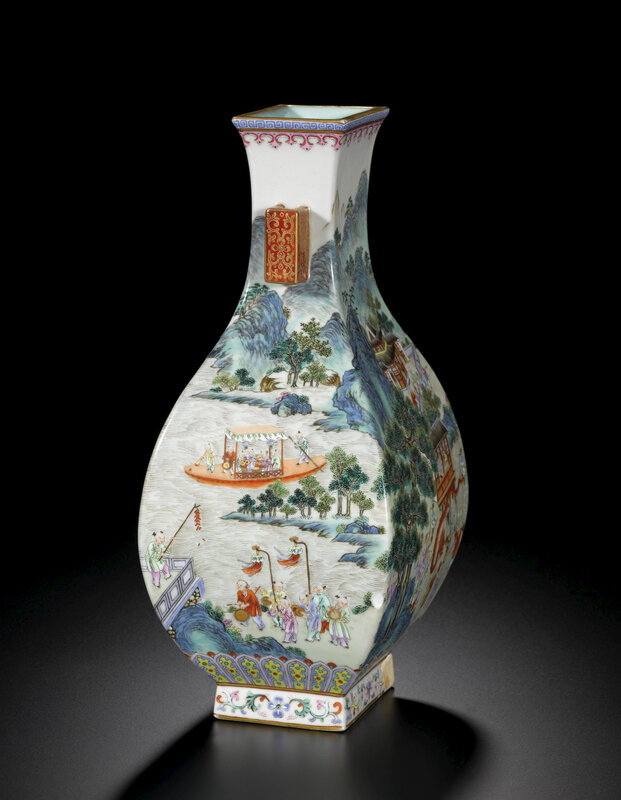Sotheby's. Fine Chinese Ceramics & Works of Art. Hong Kong. 05 Oct 2011
A finely painted and rare famille-rose 'One hundred boys' vase, fanghu, Seal mark and period of Qianlong (1736-1795)
Lot 1959. A finely painted and rare famille-rose 'One hundred boys' vase, fanghu, Seal mark and period of Qianlong (1736-1795); 32.5 cm., 12 3/4 in. Estimate 7,000,000 — 9,000,000 HKD (674,841 — 867,652 EUR). Lot sold 10,740,000 HKD (1,035,398 EUR). Photo Sotheby's
of rectangular section, each side painted with a continuous festival scene of boys at play, some performing a lion dance, some crossing a bridge on hobby-horses, and others playing various musical instruments, all within a pavilion garden landscape beneath towering mountains, the neck flanked by a pair of iron-red lug handles painted with lotus floral scrolls in gilt, the flared mouth bordered by a blue key-fret band and a pink pendant trefoil collar, all supported on a slightly splayed foot painted with floral scrolls, the base glazed turquoise and inscribed with a six-character iron-red reign mark.
Vibrantly decorated with a continuous scene of boys engaged in activities during a Dragon Boat Festival, the present vase is extremely rare for its form and no other closely related example appears to have been published. While the form has its roots in the archaic fanghu of the Han dynasty (206BC-AD220), the Qing craftsman has skilfully elongated the neck and replaced the ringed mask handles with tubular handles to update the form to a style suitable to contemporary taste.
The vast landscape is successfully captured through the long shape of the vase, thus allowing the mountainous landscape to stretch up the neck. Its vertical format coupled with the finely detail and tonal palette of the trees and mountains are reminiscent of landscape scroll paintings of the period. Furthermore, the craftsman cleverly incorporated the severe square section of the vase to successfully render four festive scenes on each side of the vase while retaining the unity of a continuous scene.
The subject of 100 boys (baizi) dates back to the Song dynasty (960-1279) and the depiction of children engaged in games and outdoor activities is symbolic of longevity, prosperity and well-being, as well as the embodiment of adult aspirations. A popular subject during the Ming period, it was revived under the Qianlong emperor and vases of various forms were painted with playful scenes in a style similar to the present, but usually between colour ground borders; see a larger vase of baluster form and high shoulders between yellow ground borders, published in The Complete Collection of Treasures of the Palace Museum. Porcelains with Cloisonné Enamel Decoration and Famille Rose Decoration, Hong Kong, 1999, pl. 121; an ovoid vase with green borders, in the Shanghai Museum, Shanghai, illustrated in Chugoku toji zenshu, vol. 21, Kyoto, 1981, pl. 117; and another ovoid vase with ruby-ground borders, from the J.M. Hu collection, sold in our New York rooms, 4th June 1985, lot 69.
Dragon Boat (Longchuan) races are held during the Duanyang or Duanwu Festival which happens on the fifth day of the fifth lunar month. The festival became a tradition to commemorate the death of Qu Yuan (c. 340-278BC), a patriotic statesman and poet from the Southern Chu state of the Warring States period. Qu drowned himself near Dongting Hu in Hunan province as a protest against the decadent and corrupt court, which collapsed consequently. The Dragon Boat race itself is a symbolic act of searching for Qu's body and to keep fish and evil spirits away from him by beating drums and splashing the water with paddles. Food is thrown into the water as offering and to distract the fish away from his body. A pair of yellow ground moonflasks decorated with shaped panels enclosing similar scenes of one hundred boys in dragon boating pursuits was sold in these rooms, 11th April 2008, lot 2921.

/https%3A%2F%2Fprofilepics.canalblog.com%2Fprofilepics%2F1%2F0%2F100183.jpg)
/https%3A%2F%2Fstorage.canalblog.com%2F03%2F02%2F119589%2F96711876_o.jpg)
/https%3A%2F%2Fstorage.canalblog.com%2F11%2F31%2F119589%2F94773502_o.jpg)
/https%3A%2F%2Fstorage.canalblog.com%2F20%2F83%2F119589%2F94772815_o.jpg)
/https%3A%2F%2Fstorage.canalblog.com%2F26%2F72%2F119589%2F75604929_o.jpg)
/https%3A%2F%2Fstorage.canalblog.com%2F59%2F60%2F119589%2F26458628_o.jpg)







/http%3A%2F%2Fstorage.canalblog.com%2F98%2F60%2F119589%2F129446628_o.jpg)
/http%3A%2F%2Fstorage.canalblog.com%2F48%2F84%2F119589%2F129332637_o.jpg)
/http%3A%2F%2Fstorage.canalblog.com%2F70%2F65%2F119589%2F128497250_o.jpg)
/http%3A%2F%2Fstorage.canalblog.com%2F62%2F84%2F119589%2F128166093_o.jpg)